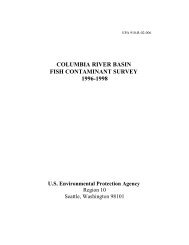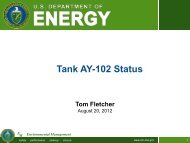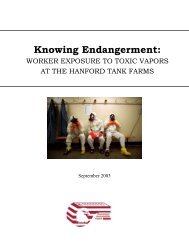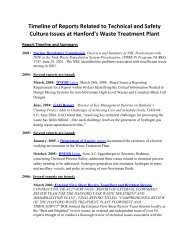Reducing the Risks of High-Level Radioactive Wastes at Hanford
Reducing the Risks of High-Level Radioactive Wastes at Hanford
Reducing the Risks of High-Level Radioactive Wastes at Hanford
Create successful ePaper yourself
Turn your PDF publications into a flip-book with our unique Google optimized e-Paper software.
74 Alvarez<br />
wastes. 182,183 DOE plans to dispose <strong>of</strong> failed melters in an onsite trench 184 even<br />
though <strong>Hanford</strong> “currently does not have <strong>the</strong> capability to ...dispose <strong>of</strong> failed,<br />
highly contamin<strong>at</strong>ed processing equipment.” 185 DOE researchers advise th<strong>at</strong>,<br />
“it is unacceptable to place this waste form in rel<strong>at</strong>ively uncontrolled long-term<br />
storage and to continue to add more <strong>of</strong> <strong>the</strong> same and o<strong>the</strong>r equipment....” 186<br />
Bulk Vitrific<strong>at</strong>ion. Bulk vitrific<strong>at</strong>ion is a supplemental tre<strong>at</strong>ment technology<br />
which is expected to process 60 to 70 percent <strong>of</strong> single-shell tank wastes. It<br />
involves <strong>the</strong> superhe<strong>at</strong>ing <strong>of</strong> wastes mixed with soils containing glass-forming<br />
m<strong>at</strong>erials (i.e., silica, sand) with large electrodes in a large metal container.<br />
When <strong>the</strong> wastes are glassified <strong>the</strong> electrodes (melter) remain embedded in <strong>the</strong><br />
glassified m<strong>at</strong>erial and are disposed with <strong>the</strong> waste. Numerous bulk vitrific<strong>at</strong>ion<br />
containers are planned, with a test project using wastes from a <strong>Hanford</strong><br />
tank scheduled for next year. Like <strong>the</strong> melters in <strong>the</strong> Waste Tre<strong>at</strong>ment Plant,<br />
<strong>the</strong> success and safety <strong>of</strong> bulk vitrific<strong>at</strong>ion will be very dependant on pretre<strong>at</strong>ment<br />
and feed prepar<strong>at</strong>ion. Several processing steps prior to vitrific<strong>at</strong>ion have<br />
to be worked out such as: dissolution <strong>of</strong> salts for retrieval, recrystalliz<strong>at</strong>ion,<br />
chemical pretre<strong>at</strong>ment, and a high-degree <strong>of</strong> moisture reduction in soil and feed.<br />
As mentioned bulk vitrific<strong>at</strong>ion poses potentially serious long-term groundw<strong>at</strong>er<br />
impacts from secondary wastes. 187 A steam explosion in 1991 <strong>at</strong> <strong>Hanford</strong>,<br />
using in situ vitrific<strong>at</strong>ion with a 6,000 gallon tank, should serve as warning, as<br />
DOE proceed with its initial efforts to deploy this technology.<br />
NOTES AND REFERENCES<br />
1. Robert Alvarez and Arjun Makhijani, <strong>Radioactive</strong> Waste: <strong>the</strong> Hidden Legacy <strong>of</strong> <strong>the</strong><br />
Nuclear Arms Race, Technology Review, July 1988.<br />
2. U.S. Department <strong>of</strong> Energy, Plutonium: The First 50 Years, United St<strong>at</strong>es Plutonium<br />
Production, Acquisition, and Utiliz<strong>at</strong>ion from 1944 through 1994 http://www.<br />
osti.gov/html/osti/opennet/document/pu50yrs/pu50yc.html#ZZ15, 20 July 2004.<br />
3. U.S. Department <strong>of</strong> Energy, Summary d<strong>at</strong>a on <strong>Radioactive</strong> Waste, Spent Nuclear<br />
Fuel and Contamin<strong>at</strong>ed Media, Office <strong>of</strong> Environmental Management, 2001.<br />
4. The Savannah River Site, Aiken SC, <strong>the</strong> Idaho N<strong>at</strong>ional Labor<strong>at</strong>ory, Idaho Falls,<br />
ID, <strong>the</strong> West Valley Vitrific<strong>at</strong>ion Demonstr<strong>at</strong>ion Project, West Valley, NY, and Oak Ridge<br />
N<strong>at</strong>ional Labor<strong>at</strong>ory, Oak Ridge, TN.<br />
5. United St<strong>at</strong>es General Accounting Office, Report to <strong>the</strong> Chairman, Subcommittee<br />
on Oversight and Investig<strong>at</strong>ions, Committee on Energy and Commerce, House <strong>of</strong><br />
Represent<strong>at</strong>ives, “Nuclear Waste: Challenges to Achieving Potential Savings in DOE’s<br />
<strong>High</strong>-<strong>Level</strong> Waste Cleanup Program,” GAO-03-593, June 2003. pp, 17, 20 (Hereafter<br />
known as GAO-03-593). “Uncontrolled cost overruns, numerous schedule delays, and<br />
unsuccessfully <strong>at</strong>tempts to develop tre<strong>at</strong>ment processes have pushed <strong>the</strong> overall estim<strong>at</strong>ed<br />
cost <strong>of</strong> <strong>the</strong> high-level waste program from about $63 billion in 1996 (when <strong>the</strong><br />
first comprehensive estim<strong>at</strong>es were developed) to nearly $105 billion in 2003.”<br />
6. GAO-03-593, 2003. p. 17 and p. 20.<br />
7. U.S. Department <strong>of</strong> Energy, “Review <strong>of</strong> Gener<strong>at</strong>ion and Flow <strong>of</strong> Recycled Uranium<br />
<strong>at</strong> <strong>Hanford</strong>, ” Richland Oper<strong>at</strong>ions Office, DOE/RL-2000-43, Executive Summary, p. 2.







